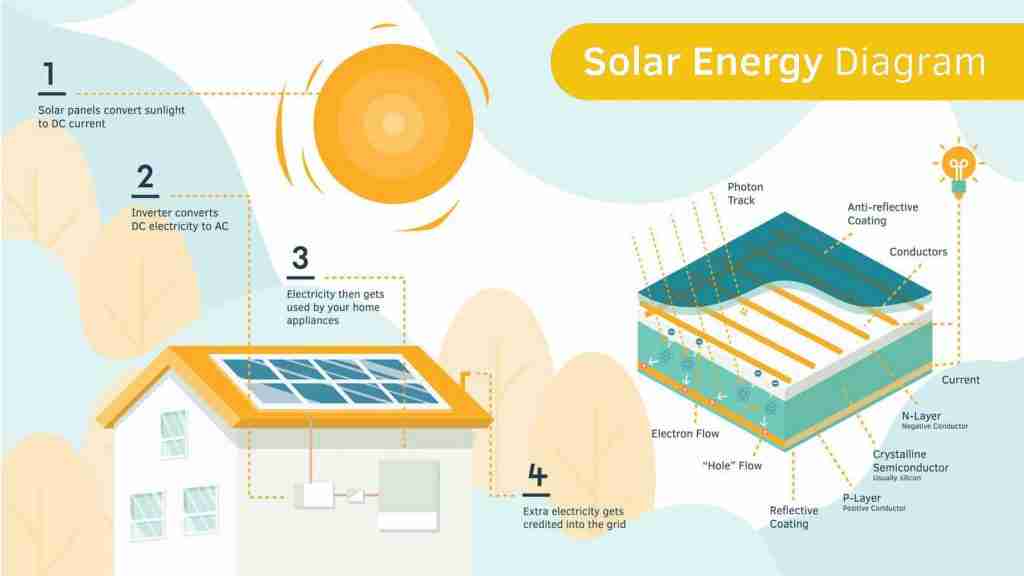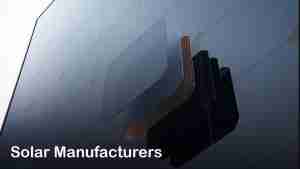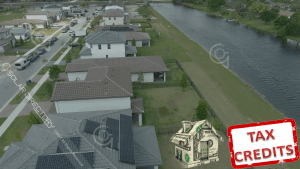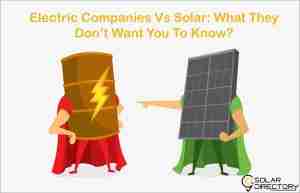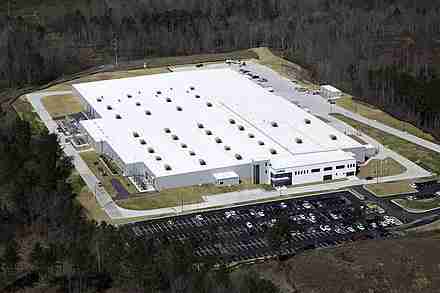How Solar Power Systems Works
To understand how solar power systems works, you need to understand how solar cells operate. A silicon semiconductor absorbs a large percentage of the sun’s energy and knocks out an electron. The energy collected in the solar panel is then converted into an electrical current by a semiconductor known as a photovoltaic cell. The solar panels are grouped together into arrays. Each panel has metal frames and glass casings, and each panel is connected to a wiring system.
The output of solar power system is measured in Kilowatt-Hour. A solar power inverter converts the DC power from solar panels into AC, which can be used in the home. Once the inverter has processed the electricity, it feeds it back to the meter. This AC electricity can then be exported back into the grid and power poles. As an example, if 10, 100-Watt light bulbs are left on for an hour, FPL will bill you for a Kilowatt-Hour.
The solar panel is composed of multiple solar cells linked together, each with a positive and negative layer. The positive layer is created by phosphorus in the top silicon layer. The bottom silicon layer provides the positive charge. The panels will generate electricity as the sun rises and set the sun. If you have a battery bank, you can use this electricity when you don’t need it. You can use the credits for other purposes.
When it comes to storing excess energy from the sun, solar panels can store the energy, and feed the surplus into the grid when needed. If you produce more power than your home needs, you can export the excess to the grid and keep the excess for future use. If you use more than 15 amps per day, your system will automatically switch back to a grid-connected system. If you do not consume the energy, you can also save energy and lower your utility bills.
The solar panel is the part of the solar power system that converts sunlight into electricity. The solar panel is made of multiple wafer-thin layers that have a positive and negative charge. The top layer is the negative layer, while the bottom is the positive. Each layer is separated by a semi-conducting material. After converting the DC to AC, the electricity is sent to your appliances and the grid. In turn, you pay only for the electricity you use.
A solar panel is a solar cell. It contains a semiconductor that is positively and negatively charged. The semiconductor absorbs energy from the sun and converts it to electricity. If a solar panel is connected to a grid, the electricity will be transferred from the grid to the electrical panel. Using a net-meter means that you’ll be able to export electricity to the grid when you need it. The electric company will send the electricity to your home.
A solar panel converts the thermal energy of the sun to electricity. It also uses the same components as grid power. A solar panel is made up of silicon-based photovoltaic cells that absorb and store light. These cells are protected by a glass or metal shell and are enclosed in a larger silicon cell. The photovoltaic cells in a solar panel convert sunlight into electrons, which are then converted into the AC current we use in our home.
A solar panel is an energy source that transforms solar energy into electrical current. The photons emitted by the sun cause an electric current. Inverters convert this energy into heat, which is used to create electricity. The energy is converted into direct current in an electric circuit. If it is more efficient, it is possible to store this heat for later use. The photovoltaic panel can be linked to a battery to create more current.
A solar panel works by converting light from the sun into electricity. A standard solar panel consists of a layer of silicon cells and various wiring. The silicon cells are connected to a metal frame, which is called a solar inverter. A standard solar panel can use a wide range of voltage to power a household. The electricity it produces can be exported to the grid or used for any other purpose. The cost of a solar energy system is minimal compared to the amount of money it can save.
The Different Types of Solar Panels
There are three main types of solar panels: monocrystalline, polycrystalline, and thin-film. Monocrystalline panels are the most efficient, generating the highest amount of electricity per square foot. They are also the most expensive to purchase. On the other hand, polycrystalline panels tend to be cheaper but produce less electricity. Both types of panels are useful for portable solar systems. If you are considering purchasing a solar power system for your home, it is important to know about the different types of solar panels available.
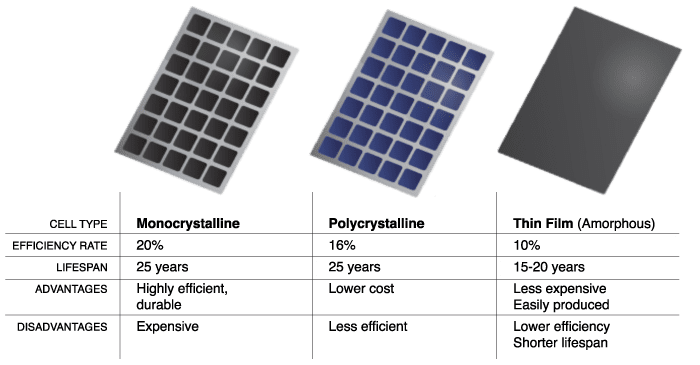
Monocrystalline
Monocrystalline solar panels are the most efficient of all three types. The silicon crystals are square and cut from a mold. These panels are made from 40 monocrystalline cells. The molten silicon is slowly poured into a vat, where the crystal forms a solid shell around the wafer. Once the crystal forms, it is slowly pulled out and then sliced into individual silicon cells. The process of making monocrystalline solar panels is very simple.
Although monocrystalline solar panels are the most efficient, they cost more. The monocrystalline manufacturing process requires a high amount of silicon, which is then passed onto the consumer.
Polycrystalline
Polycrystalline panels are made from many small fragments of silicon crystal. As a result, they don’t generate as much electricity from the sun as monocrystalline solar panels.Polycrystalline solar cells are made of a mixture of silicon and metal, resulting in a more blueish color. They require more space than monocrystalline solar cells, due to the lower efficiency and a shorter lifespan. For this reason, you should choose a monocrystalline solar panel if you can afford it because they are much more efficient and durable.
Thin Film
Thin-film solar panels have lower wattage modules, and not currently used in home solar power systems due to their low efficiency. They are most often used in smaller devices like solar lights. A thin-film panel is the cheapest option, but a high-quality monocrystalline panel will increase the value of your property.
The monocrystalline solar panel is the most common type. Its name comes from the fact that it is the most ancient type of solar panel. Its name derives from the fact that its silicon cells are monocrystalline. In comparison to polycrystalline panels, polycrystalline solar panels have more expensive components. They are less durable and can be used for large-scale installations. They are also less efficient than monocrystalline panels. This makes them suitable for use in industrial settings.
The Different Components of a Solar Power System
There are various different components in a solar panels system, each with its own role and purpose. The PV modules are the most obvious, and most obvious of these are the panels themselves. The other components, such as the battery-based inverter/charger, are just as crucial. They manage the energy between the array and the grid, regulate charging and maintain a balanced battery state. The PV modules are often mounted at an angle depending on the latitude of the user.

There are various different components in a solar panels system, each with its own role and purpose. The PV modules are the most obvious, and most obvious of these are the panels themselves. The other components, such as the battery-based inverter/charger, are just as crucial. They manage the energy between the array and the grid, regulate charging and maintain a balanced battery state. The PV modules are often mounted at an angle depending on the latitude of the user.
A charge controller is an important part of the solar panels system. It regulates the amount of electric current and voltage that the PV modules are able to produce. It also limits the amount of electricity that is withdrawn from the batteries. A charge controller can also limit the number of watts that are generated by the solar array. To understand the differences between these two parts of the solar panels system, it is helpful to understand their function.
The MC4 connectors are a common way to interconnect solar panels. They are the most common type of solar panel connectors, which allow the panels to be connected in series or parallel. These connectors are very effective in eliminating hot spots on the cells and minimizing the effects of shading. There are several methods that are available for determining the amount of shade a PV system receives from trees. LiDAR and 3D modeling are two of the most common methods for calculating the amount of power that a PV installation can generate.
An inverter is another important component. An inverter is an electrical enclosure that converts direct current (DC) to AC. Without this, solar energy systems would not function properly and would not be usable. The DC-AC conversion is necessary for most electric devices. These components are essential for the performance of a solar energy system, so it is essential to choose the right one. Some inverters have an integrated circuit breaker.
The DC/AC inverter is a high-quality power-conversion device that connects a solar panel array to an electrical panel. It is an efficient device, but it is not ideal for most residential systems. Because it has a low efficiency, it is often less effective than other types of inverters. Microinverters can provide a much higher efficiency and are typically more expensive. It is also important to understand that a string inverter can connect several strings without a combiner box.
A PV Optimizer is the most expensive component of a solar power system. It is installed on the back of each solar module and is applied to each one. It is a high-tech component that is essential for the overall efficiency of a solar power system. A PV optimizer can increase the yield of a solar PV module by up to 30 percent. The master controller is connected to each of the individual PV modules and communicates with the individual tracker controllers.
In addition to solar panels, other components of a solar power system are equally important. The MPPT electronic device is necessary for simple PV systems. It allows the PV modules to match the voltage of the battery. The MPPT electronics are not required for larger PV systems. They are optional for residential installations. The inverter can also help improve the performance of the PV array under shaded conditions. They are not necessary for most commercial rooftops, but can improve the performance of the entire system.
When building a solar panel electrical system, it is important to keep in mind that the electricity produced by the panels must be fed into a bidirectional circuit. The breaker panel, which joins the PV system to the building’s circuit, is the critical component in a solar panels system. The breaker panel is responsible for controlling the voltage of the batteries. It can protect the electrical systems from the variable energy flux.
The inverter is a vital piece of a solar panels system. It converts DC electricity into AC electricity by using solid state switches. It uses an inverter, which is a device that changes the current direction from direct current to alternating current. The mains electricity is alternating current, while solar power electricity is direct current. Unlike mains electricity, solar power electricity is similar to the electricity stored in a battery and can be used on a daily basis.
Net Metering - Benefits and Drawbacks
Net metering allows the consumer to use electricity whenever they need it. Especially important for renewable energy sources, such as wind and solar, net metering allows a consumer to use electricity anytime they want. However, it is important to understand how it works before implementing it. This article will discuss some of the main benefits and drawbacks of net meters. Also, learn about the history of net metering in the U.S.
With net metering, excess generation is compensated by utilities on a twelve-month cycle, with the percentage varying from one hundred to 15%. These credits are reusable for a year, but some regions have considered a cap of 36 months. While this is rare, the best practices call for the credits to be permanently rollover. This means that if a customer has excess generation, they will continue to receive the credits.
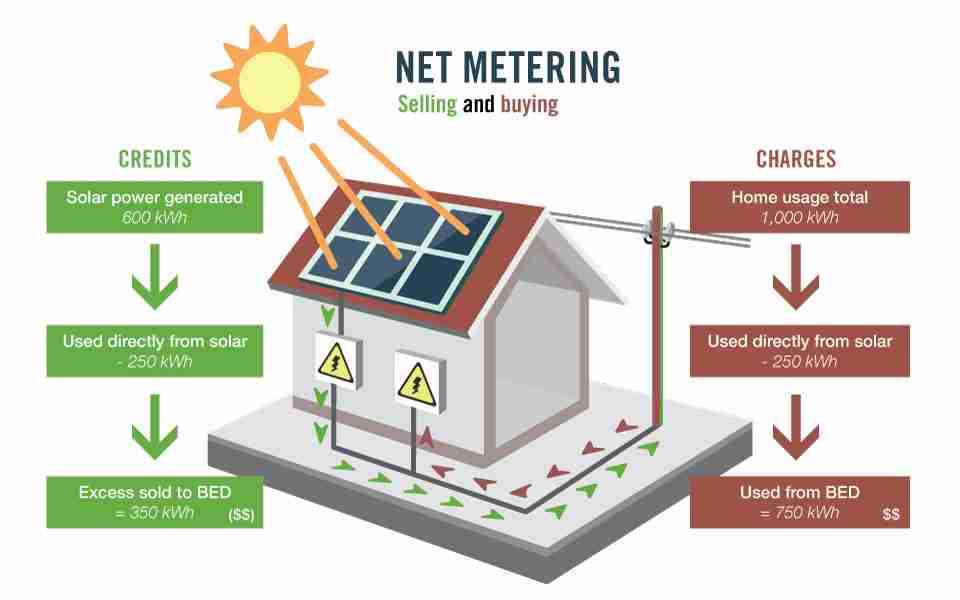
Customers who generate excess energy can store that power until it is needed again. This is especially helpful for solar and wind power generators, which typically have fewer hours of daylight during the day. With net metering, they can purchase excess electricity from the utility and offset it with their own generation. The energy is then returned to the customer’s account. This benefit is beneficial for both sides of the equation. It is also important to know how to change your net metering credit allocation. You may want to consult your service provider about this option.
Unlike other types of net metering, NEM enables consumers to shift demand to cheaper times of day. For example, a residential net metering system can generate and send energy to the grid. If the consumer’s electricity is generated during a low time of day, the utility will be able to bill it at a lower rate. In addition, customer-generators are entitled to receive full retail value for every kWh they produce.
The main disadvantage of net metering is that it is difficult to collect revenue from customers. It is important to remember that there are some restrictions on the amount of electricity that a customer can produce. Moreover, the installation of a net metering system in the house can be expensive. Besides, it can also cause problems with the utility’s finances. For instance, it can affect the company’s profit margins. Using solar panels and wind power in the home reduces the company’s profits.
There are several advantages to net metering. The cost of solar is much cheaper than that of electricity generated from conventional energy. In addition, a customer-generator can earn a lot of money while reducing their carbon footprint. The cost of installing net metering systems is low. They will pay for the excess power produced and keep it for themselves. It will also help them to save money in the long run. These systems have a lower cost than a traditional utility.
There are several different types of net metering policies. There are two types of net metering policies: Tier 1 and Tier 2. If the customer uses solar panels in his home, he will get an annual credit, which will reduce his monthly electric bills. In addition to the benefits of net metering, it helps customers to save money. In other words, the consumer can be green and use renewable energy. This way, he or she can help the environment.
In the United States, net metering is a mandatory part of the utility’s electricity supply. This system allows the consumer to purchase excess credits and use them to offset the amount of electricity they consume. Those who sign up for net metering will enjoy the benefits of distributed solar energy. The government has also passed legislation to make it easier for people to install their own renewable energy systems. There is no limit on the number of homes in a community, so it will not affect the rate of residential consumers.
As demand for renewable energy continues to rise, the net metering policy of the utility is an important aspect of this industry. In the United States, the benefits of net metering are numerous. Not only does it help the utility to lower its fixed costs, but it also encourages homeowners to invest in solar electricity. Find out if net metering is available in your area and how much solar can save you.
